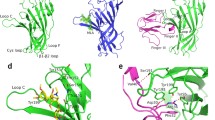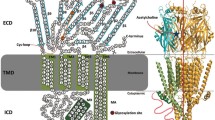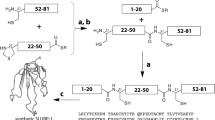Abstract
An extracellular domain (ECD) of the human α7 neuronal nicotinic acetylcholine receptor (nAChR) is implicated in a series of neurological disorders. To facilitate structural studies of this domain essential for rational drug design, we designed and expressed mutated forms of human α7 ECD in yeast Pichia pastoris. The novel mutations were based on a model we constructed for α7 ECD using crystal and electron microscopy structures of the homologous invertebrate ACh-binding protein and the Torpedo nAChR, respectively. Preliminary biochemical and physicochemical data indicated that we obtained at least one α7 ECD mutant with proper folding and increased solubility (compared to the wild-type ECD) promising for detailed structural studies.
Similar content being viewed by others
References
J. P. Changeux and S. J. Edelstein, Nicotinic Acetylcholine Receptors, Odile Jacob, Paris (2005).
J. M. Lindstrom, “Nicotinic acetylcholine receptors of muscles and nerves: comparison of their structures, functional roles, and vulnerability to pathology,” Ann. N. Y. Acad. Sci., 998, 41–52 (2003).
N. Le Novere and J. P. Changeux, “The ligand gated ion channel database,” Nucleic Acids Res., 27, 340–342 (1999).
A. Karlin, “Emerging structure of the nicotinic acetylcholine receptors,” Nat. Rev. Neurosci., 3, 102–114 (2002).
C. Gotti, M. Zoli, and F. Clementi, “Brain nicotinic acetylcholine receptors: native subtypes and their relevance,” Trends Pharmacol. Sci., 27, No. 9, 482–491 (2006).
K. Brejc, W. J. van Dijk, R. V. Klaassen, et al., “Crystal structure of an ACh-binding protein reveals the ligand-binding domain of nicotinic receptors,” Nature, 411, 269–276 (2001).
P. H. Celie, R. V. Klaassen, S. E. van Rossum-Fikkert, et al., “Crystal structure of acetylcholine-binding protein from Bulinus truncatus reveals the conserved structural scaffold and sites of variation in nicotinic acetylcholine receptors,” J. Biol. Chem., 280, 26457–26466 (2005).
S. B. Hansen, G. Sulzenbacher, T. Huxford, et al., “Structures of Aplysia AChBP complexes with nicotinic agonists and antagonists reveal distinctive binding interfaces and conformations,” EMBO J., 24, 3635–3646 (2005)
N. Unwin, “Refined structure of the nicotinic acetylcholine receptor at 4Å resolution,” J. Mol. Biol., 346, 967–989 (2005).
V. Avramopoulou, A. Mamalaki, and S. J. Tzartos, “Soluble, oligomeric, and ligand-binding extracellular domain of the human alpha7 acetylcholine receptor expressed in yeast: replacement of the hydrophobic cysteine loop by the hydrophilic loop of the ACh-binding protein enhances protein solubility,” J. Biol. Chem., 279, 38287–38293 (2004).
J. D. Thompson, D. G. Higgins, and T. J. Gibson, “CLUSTAL W: improving the sensitivity of progressive multiple sequence alignment through sequence weighing, position-specific gap penalties and weight matrix choice,” Nucleic Acids Res., 22, 4673–4680 (1994).
A. Sali and T. L. Blundell, “Comparative protein modelling by satisfaction of spatial restraints,” J. Mol. Biol., 234, 779–815 (1993).
T. Schwede, J. Kopp, N. Guex, and M. C. Peitsch, “SWISS-MODEL: An automated protein homology-modeling server,” Nucleic Acids Res., 31, 3381–3385 (2003).
B. R. Brooks, R. E. Bruccoleri, B. D. Olafson, et al., “CHARMM: a program for macromolecular energy minimization and dynamics calculations,” J. Comput. Chem., 4, 165–175 (1983).
M. Zouridakis, K. Kostelidou, A. Sotiriadis, et al., “Circular dichroism studies of extracellular domains of human nicotinic acetylcholine receptors provide an insight into their structure,” Int. J. Biol. Macromol., doi: 10.1016/j.ijbiomac.2007.05.012 (2007).
N. Sreerama and R. W. Woody, “Estimation of protein secondary structure from circular dichroism spectra: comparison of CONTIN, SELCON, and CDSSTR methods with an expanded reference set,” Anal. Biochem., 287, 252–260 (2000).
Author information
Authors and Affiliations
Corresponding author
Additional information
Neirofiziologiya/Neurophysiology, Vol. 39, Nos. 4/5, pp. 302–306, July–October, 2007.
Rights and permissions
About this article
Cite this article
Zouridakis, M., Zisimopoulou, P., Eliopoulos, E. et al. Recombinant extracellular domains of human neuronal nicotinic receptors: Preliminary studies on mutant forms for the improvement of solubility. Neurophysiology 39, 259–263 (2007). https://doi.org/10.1007/s11062-007-0036-3
Issue Date:
DOI: https://doi.org/10.1007/s11062-007-0036-3




